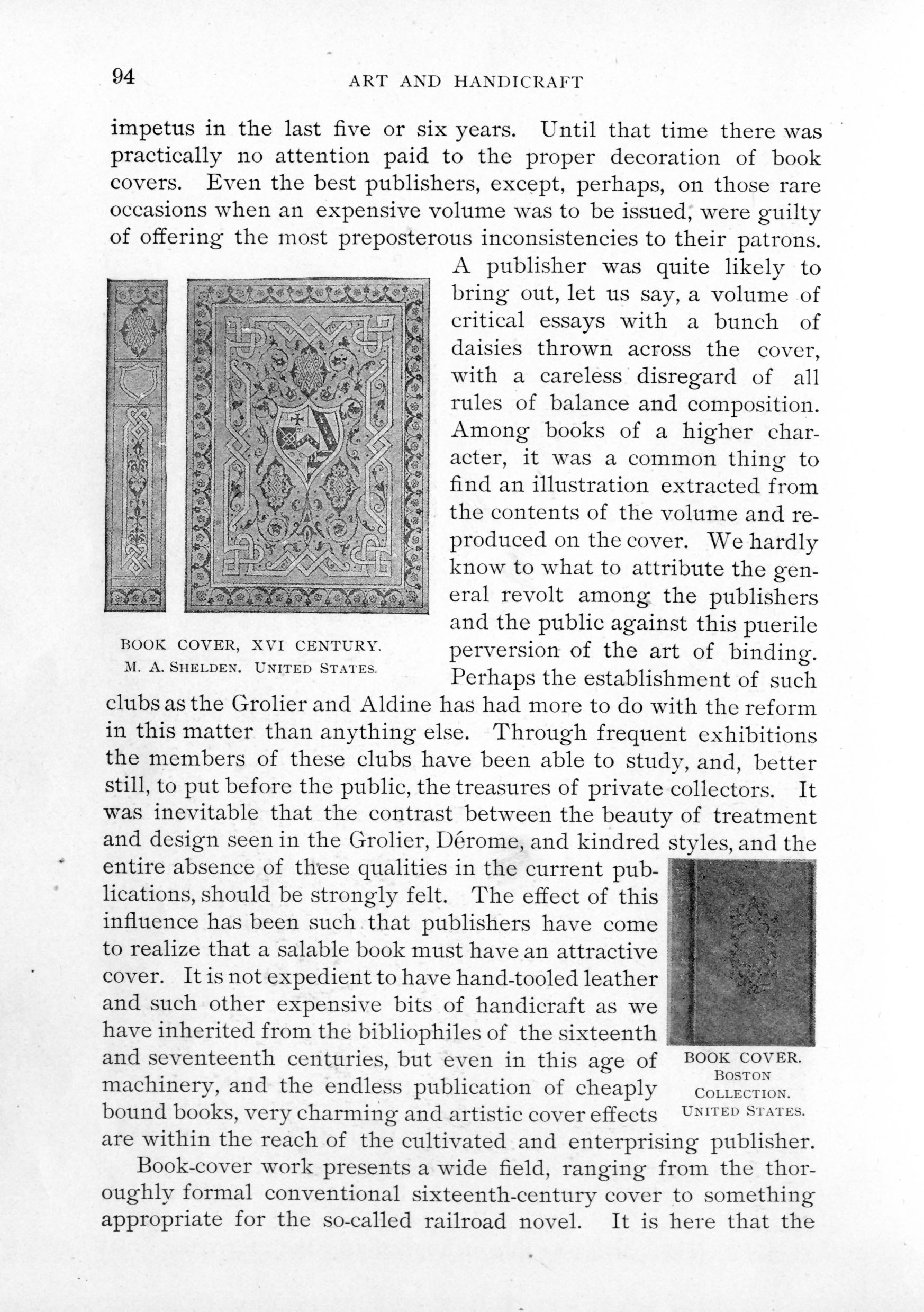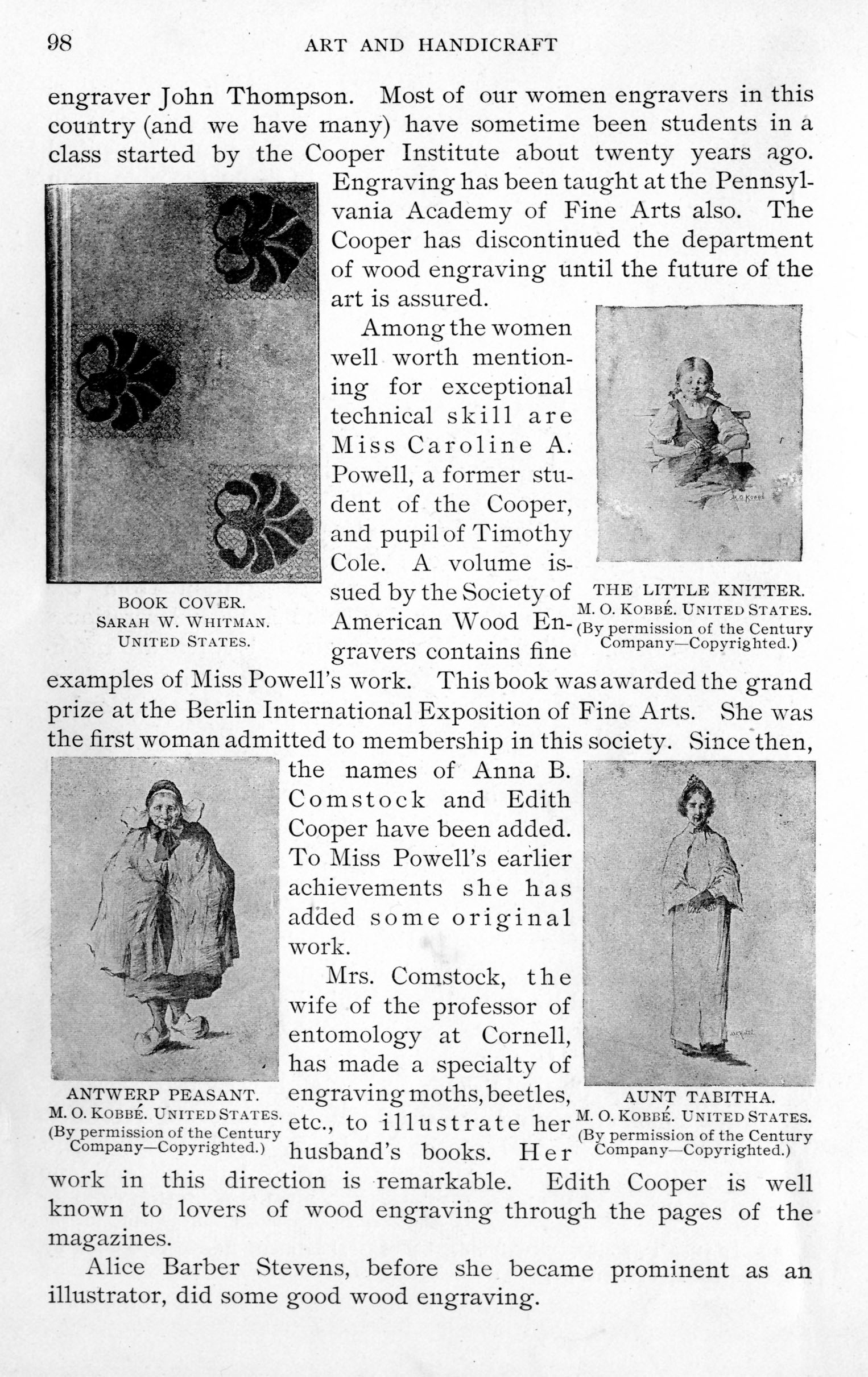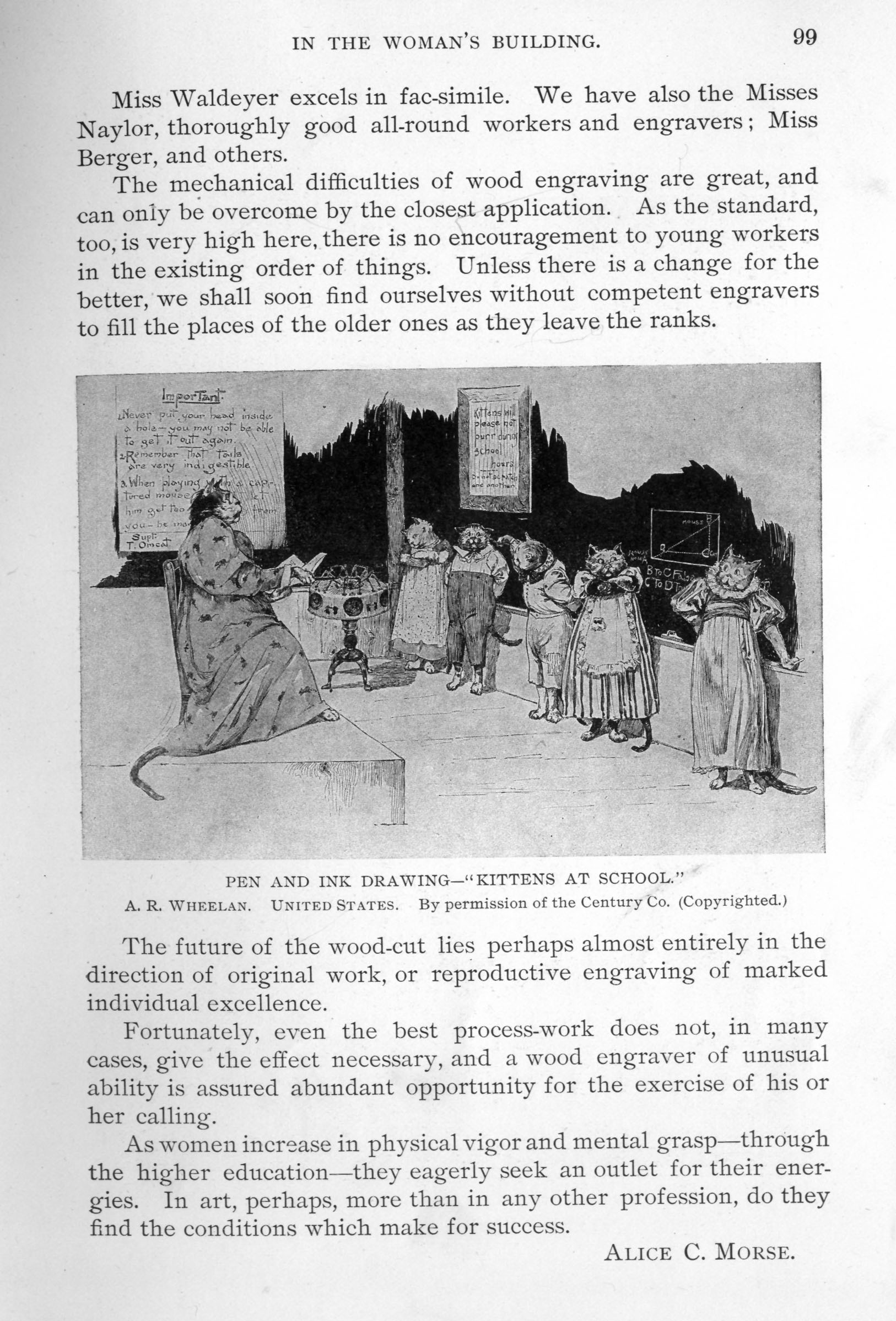
"THE LETTER OF RESIGNATION."
MARY HALLOCK FOOTE,
UNITED STATES.
By permission of the Century Co.
(Copyrighted.)
WOMEN ILLUSTRATORS.
CONTRASTING the Columbian Exposition with our Centennial, the thoughtful observer is impressed with the great advance in art sentiment, in all phases of its expression, since that time.
Women have not been left behind in the march of events, and that their advance along the lines of progress and culture has been phenomenal is the only conclusion that can be arrived at after studying the subject. If this be true, speaking generally—and the most casual observer will hardly deny the statement—it is particularly pertinent in regard to their hold on art.
There is no branch of art that shows more conclusively the higher standards demanded from its devotees among all classes of people than illustration. About twenty years ago, we could count on the fingers of one hand all the women seriously engaged in this work; nor was it until the advent of Mrs. Mary Hallock Foote in the field, as the illustrator of her own charming stories, that illustration seemed to present an opening for women. Having obtained an entering wedge, they were not long in availing themselves of their opportunity, and now it is an acknowledged fact that any woman possessing the requisite talent, training, and practical experience in working for reproduction, is assured a profitable return for her labor. The feminine mind has ceased to view a professional career as a thing of a few years only, a mere incident in her life to bridge over some financial crisis, or gratify a whim; nor is she following art in a dilettante spirit. She enters our schools and

DESIGNS FOR BOOK COVERS.
ALICE C. MORSE
(by permission of Messrs. G. P. Putnam & Sons).
UNITED STATES.
studios with a determination to learn all she possibly can from steady, grinding, academic work, and from her teachers. To this end she spends years in the up-hill, uninteresting pursuit of training the eye to a sense of proportion and construction before she attempts really serious work. She has learned to "wait with all her might."
If there is one characteristic beyond another that the average American woman possesses, it is an "instinct for expansion." She has an unquenchable thirst for information, a love of knowledge for its own sake; this actuating impulse has resulted in her development in all directions. If we consider Mrs. Foote the pioneer as an artist illustrator, it seems incredible that, considering the comparatively few years her drawings have been before the public, there should be so many illustrators to dispute the field with her. Let us take, for instance, Dora Wheeler Keith, whose figure-work shows a grace of line and sense of balance indicating a strong decorative tendency, and an insight into the realm of fanciful creation. Rosina E. Sherwood's illustrating possesses solid qualities and evidences of versatility in handling and subject, her drawings ranging from purely imaginative creations to the delineation of ultra-fashionable life. Rhoda Holmes Nicholls stands at the very head and front as a painter in water-colors, and is the recipient of medals both here and abroad. Though an English

ILLUSTRATED PAGE FROM NURSERY RECEIPTS.
MARY HATHAWAY NYE.
UNITED STATES.
DESIGN FOR BOOK COVER.
MARY HATHAWAY NYE.
UNITED STATES.
woman by birth and training, she has found in America her greatest success. A strong sense of the picturesque, good draughtsmanship, and an unerring handling of her medium, characterize her illustrative work.
Philadelphia is justly proud of Alice Barber Stephens. She has marked ability, a general all-round capacity for grasping the salient point in a story, and illustrating it sympathetically.
The pen-drawings of Allegra Eggleston are well "understood;" they show careful training and individuality of style. Her portrait work with the pen is particularly clever.
Lydia Field Emmet is in her happiest vein in depicting children. She is so successful here that one would almost wish she would confine herself exclusively to this field.
There is a constantly growing demand for good illustrators who can give a natural, sympathetic rendering of child-life. Miss Emmet is not, however, by any means alone in the arena. Among the contributors to children's periodicals are Miss Hills, equally sure in strong, bold outline and extremely delicate pen and ink work; Miss Kobbé, with her clever character sketches; Katherine Pyle, recognized by a certain quaint originality, and Miss Minna Brown; in fact nearly all the women illustrators work more or less for children's magazines. We regret the withdrawal of Maria Oakey Dewing from magazine work; nor do we see often enough the charming flower studies, full of delicacy and feeling, which Mrs. Richard Watson Gilder occasionally gives us. Albertine Randall Wheelan shows great originality, a remarkable sense of the humorous, and a daring handling of the pen.

ETCHING—PORTRAIT OF MRS. PIPER AT SPINNING WHEEL.
E. PIPER. ENGLAND.

NEEDLEWORK PANEL.
MISS ELIOT WALKER.
ENGLAND.
BOOK COVER.
DESIGNED BY SARAH W. WHITMAN.
UNITED STATES.
We enjoy hugely her Chinamen, cats, and other amusing creations. They are real beyond a shadow of a doubt, and one is positive that they have done, and will do again, all the ludicrous things that Mrs. Wheelan represents them as doing.
With the exception of Madelaine Lemaire and a few others, it is difficult to find any women illustrators abroad of much prominence. It sometimes seems that our best magazines, which in accepting only good work have raised illustration to a fine art, have done more toward disseminating a general art culture in the United States than any other single influence.
Now that it is possible to reproduce, by different processes, all kinds of sketches, we find not only pen and ink but lead pencil, crayon, gouache, aquarelle, pastel, and even oil, rendered with great success. The illustrator has all the delights of using these different mediums and yet working toward a practical result.
Illustration opens so wide and attractive a vista, occupies so high a place in the art of this country, and is withal so remunerative, that women would do well to follow it more largely than they have done heretofore.
A gentleman who is an acknowledged authority on illustration, in lecturing to a class of art students on the pros and cons of working for reproduction, said that to be a successful illustrator one must have, among other qualities, "ingenuity and invention." If this be true of illustration, it applies preeminently to book-cover designing. This particular line of applied arts has received a great

BOOK COVER, XVI CENTURY.
M. A. SHELDEN.
UNITED STATES.
BOOK COVER.
BOSTON COLLECTION.
UNITED STATES.
impetus in the last five or six years. Until that time there was practically no attention paid to the proper decoration of book covers. Even the best publishers, except, perhaps, on those rare occasions when an expensive volume was to be issued, were guilty of offering the most preposterous inconsistencies to their patrons. A publisher was quite likely to bring out, let us say, a volume of critical essays with a bunch of daisies thrown across the cover, with a careless disregard of all rules of balance and composition. Among books of a higher character, it was a common thing to find an illustration extracted from the contents of the volume and reproduced on the cover. We hardly know to what to attribute the general revolt among the publishers and the public against this puerile perversion of the art of binding. Perhaps the establishment of such clubs as the Grolier and Aldine has had more to do with the reform in this matter than anything else. Through frequent exhibitions the members of these clubs have been able to study, and, better still, to put before the public, the treasures of private collectors. It was inevitable that the contrast between the beauty of treatment and design seen in the Grolier, Dérome, and kindred styles, and the entire absence of these qualities in the current publications, should be strongly felt. The effect of this influence has been such that publishers have come to realize that a salable book must have an attractive cover. It is not expedient to have hand-tooled leather and such other expensive bits of handicraft as we have inherited from the bibliophiles of the sixteenth and seventeenth centuries, but even in this age of machinery, and the endless publication of cheaply bound books, very charming and artistic cover effects are within the reach of the cultivated and enterprising publisher.
Book-cover work presents a wide field, ranging from the thoroughly formal conventional sixteenth-century cover to something appropriate for the so-called railroad novel. It is here that the

Engraved by Rand, McNally & Co.
EASTERN FAÇADE OF THE MINES AND MINING BUILDING, AS SEEN FROM THE SOUTH.

Engraved by Rand, McNally & Co.
STATUE OF THE REPUBLIC.
BY MR. D. C. FRENCH.
THE PERISTYLE.
STATUE OF THE BULL.
BY MESSRS. E. C. POTTER AND D. C. FRENCH.

BOOK COVER.
ALICE C. MORSE.
UNITED STATES.
By permission of the Century Co.
(Copyrighted.)
BOOK COVER.
BOSTON COLLECTION.
UNITED STATES.
illustrator's "ingenuity and invention" is called into play. It is not enough to have a pretty extensive knowledge of historic ornament; she must be able to extract from a book its central idea, and reduce this thought, if possible, to some tangible form permitting a conventional treatment. She must not outrage any true standards of design, yet she should be able to suggest to the casual observer, in a symbolic way, the contents of the volume. Women seem to have a remarkable faculty for designing. Their intuitive sense of decoration, their feeling for beauty of line and harmony of color, insures them a high degree of success. Another consideration is the necessity of rigid, exact treatment of details; uncertain or even suggestive drawing is out of place in cover ornamentation.
Mrs. Sarah W. Whitman of Boston and Margaret N. Armstrong have taken a firm hold on the publishers, and won recognition from the public, by their appropriate, tasteful, well-studied book decoration.* The designs of Miss Sheldon, Miss Sinclair, and others are promising.
For those possessing the requisite endowment, the ever-widening prospect in cover designing is encouraging.
Just now wood engraving is suffering a temporary eclipse. Its future is problematic, owing to the process-work so much in vogue, and so inimical to the interests of the engraver. It is lamentable to have to admit that there is the slightest question in regard to the future of the wood-cut. It seems impossible that this method of a sympathetic rendering of the artist's idea by a well-trained hand and eye should be superseded by a purely mechanical means in reproduction. We detect, even now, however, symptoms of a reaction toward the old-time wood engraving among the publishers. There are records of women engraving on wood in the time of Albrecht Dürer. Since the revival of the art in England, through the work of Thomas Bewick, we find mention of but one eminent woman engraver, Elizabeth Thompson, daughter of the famous
* Miss Alice C. Morse, the writer of this paper, has made a wide reputation by her excellent and serious work in the designing of book covers.—ED.

BOOK COVER.
SARAH W. WHITMAN.
UNITED STATES.
THE LITTLE KNITTER.
M. O. KOBBÉ.
UNITED STATES.
(By permission of the Century Company—Copyrighted.)
ANTWERP PEASANT.
M. O. KOBBÉ.
UNITED STATES.
(By permission of the Century Company—Copyrighted.)
AUNT TABITHA.
M. O. KOBBÉ.
UNITED STATES.
(By permission of the Century Company—Copyrighted.)
engraver John Thompson. Most of our women engravers in this country (and we have many) have sometime been students in a class started by the Cooper Institute about twenty years ago. Engraving has been taught at the Pennsylvania Academy of Fine Arts also. The Cooper has discontinued the department of wood engraving until the future of the art is assured.
Among the women well worth mentioning for exceptional technical skill are Miss Caroline A. Powell, a former student of the Cooper, and pupil of Timothy Cole. A volume issued by the Society of American Wood Engravers contains fine examples of Miss Powell's work. This book was awarded the grand prize at the Berlin International Exposition of Fine Arts. She was the first woman admitted to membership in this society. Since then the names of Anna B. Comstock and Edith Cooper have been added. To Miss Powell's earlier achievements she has added some original work.
Mrs. Comstock, the wife of the professor of entomology at Cornell, has made a specialty of engraving moths, beetles, etc. to illustrate her husband's books. Her work in this direction is remarkable. Edith Cooper is well known to lovers of wood engraving through the pages of the magazines.
Alice Barber Stevens, before she became prominent as an illustrator, did some good wood engraving.

PEN AND INK DRAWING—
"KITTENS AT SCHOOL."
A. R. WHEELAN.
UNITED STATES.
By permission of the Century Company. (Copyrighted.)
Miss Waldeyer excels in fac-simile. We have also the Misses Naylor, thoroughly good all-round workers and engravers; Miss Berger, and others.
The mechanical difficulties of wood engraving are great, and can only be overcome by the closest application. As the standard, too, is very high here, there is no encouragement to young workers in the existing order of things. Unless there is a change for the better, we shall soon find ourselves without competent engravers to fill the places of the older ones as they leave the ranks.
The future of the wood-cut lies perhaps almost entirely in the direction of original work, or reproductive engraving of marked individual excellence.
Fortunately, even the best process-work does not, in many cases, give the effect necessary, and a wood engraver of unusual ability is assured abundant opportunity for the exercise of his or her calling.
As women increase in physical vigor and mental grasp—through the higher education—they eagerly seek an outlet for their energies. In art, perhaps, more than in any other profession, do they find the conditions which make for success.
ALICE C. MORSE.